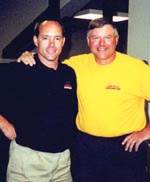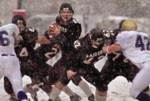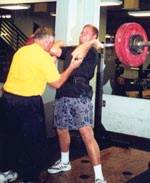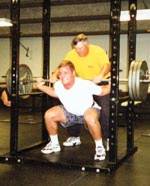FOCUSING ON SUCCESS AT SOUTHERN OREGON UNIVERSITYRoger VanDeZande has a one-man show worth watchingBy Kim Goss Published: Summer 2002 In a perfect world a head strength coach will be able to delegate most of the hands-on coaching to his or her assistants, who in turn will delegate many of their lesser responsibilities to student assistants. Such focus enables the individual players to achieve high levels of success, and gives the head strength coach more time to devote to recruiting and administrative duties. Southern Oregon University head strength coach Roger VanDeZande doesn’t live in a perfect world, but that didn’t stop him from developing one of the finest conditioning programs in the country. VanDeZande is solely responsible for supervising the conditioning programs of over 250 athletes. As if that weren’t enough, he is also the defensive coordinator for the SOU Raiders’ football team. It’s a position he takes very seriously, and last year he was honored by being named Assistant Coach of the Year by the American Football Coaches Association. Despite the considerable time demands placed on him, VanDeZande doesn’t have an extensive support staff that he can simply delegate his responsibilities to. Weight training for football---Roger’s the man. Plyometric drills for volleyball---talk to Roger. Endurance training for basketball---you guessed it---get Roger. VanDeZande was asked to coach at Southern Oregon about six years ago largely based upon his success with training the high school athletes the school often recruits. Because he was using the BFS program at the high school level and knew he would be working with a large number of athletes at SOU, VanDeZande saw no reason to depart from the program. VanDeZande uses the BFS program with all his athletes, designating the bench press, squat, power clean, push press, and hex bar deadlift as the core of their program. To make the program more sport specific, he uses slight variations of the core lifts and selects appropriate auxiliary exercises. Says VanDeZande, “I’m interested in total-body conditioning for athletes---we don’t lift like bodybuilders or powerlifters. That’s why all our core movements, with the exception of the bench press, are total-body exercises. I’ve been training athletes long enough to know what works and what doesn’t, so I don’t have to add the latest trend that comes along.” The only trend he concerns himself with is the Raiders’ drive to win, a turnaround brought about by VanDeZande and Head Football Coach Jeff Olson, who took over the head coaching job six years ago. In 1997 the team broke 12 school records along the way to enjoying its first winning season in six years. In 1999 the team posted a 7-2 record---its best since 1983---and the following year it achieved the school’s first back-to-back winning seasons since 1991. Last year the Raiders lost only one game, 38-48 against Pacific Lutheran, and reached another summit by earning its first appearance in the NAIA playoffs since 1987. In the first game of the playoffs, the Raiders dominated McKendree (Ill.), 54-10, then lost a close one to Carroll (Mont.), 13-16. Powerful Results SOU is a 175-acre campus in a contemporary public liberal arts and science university located in sunny Ashland, Oregon. The college enrollment is 5,500 and students have their choice of over 100 areas of study (including 35 majors) and enjoy the individual attention of a 17-to-1 student/professor ratio. Southern Oregon University offers its staff, students and student-athletes use of the Daniel Meyer Fitness Center, which was built in 1991 and is located under Raider Stadium. Due to the popularity of the facility, in 1999 the center was renovated and expanded to a floor space of 9,000 square feet. The facility contains primarily free weights, but also considerable cardiovascular training equipment such as treadmills, stair climbers and stationary bicycles. Due to the large size of the facility, VanDeZande insists there is no problem with the student body training at the same time as the athletic teams. “Since we expanded our facility a few years ago and because about 60 percent of the football team trains in the morning, we don’t have to limit the student body’s access to it.” The Raiders’ football team is a member of the National Association of Intercollegiate Athletics (NAIA) and its wrestling team competes in the Northwest Wrestling Conference. The remaining SOU sports---baseball (men and women), cross-country (men and women), soccer (women), tennis (women), outdoor track and field (men and women) and volleyball (women)---compete in the Cascade Conference. The Raiders’ football and track teams compete in Raider Stadium, a $1.55 million facility that was constructed in 1983 and financed by state building funds and the sale of preferred seating. It is known for its breathtaking views of prominent mountain ranges, including Cascade Range and its Grizzly Peak (elevation 5,100 feet). The football field, Fuller Field, became the permanent site of Raider home games in 1955. It was named after John Fuller, a former Ashland postmaster who was instrumental in establishing the university in 1926. Despite the relatively small size of the university, VanDeZande’s football players have strength levels comparable to many Division I programs, as evidenced by the accomplishments of its defense. VanDeZande’s defense held opponents to 14.5 yards per game and ranked in the top eight for total defense with 254.5 yards per game. And VanDeZande thinks the outlook is even better this year. “Last year we had our strongest team ever, but this year we’re even stronger. We have several athletes bench pressing over 440 and squatting over 550.” In addition to maintaining a sound lifting program, VanDeZande encourages success with a motivation program he calls his “Steak Dinner Club.” VanDeZande explains, “We have nine basic tests for football, the core lifts and vertical jump, standing long jump, pro agility shuttle and the BFS dot drill. If an athlete achieves a certain standard in one of those tests, I buy them a steak dinner.” The standards include the following: bench press, 400; squat, 500; power clean, 325; power jerk, 315; hex bar deadlift, 650; long jump, 10 feet; vertical jump, 36 inches; pro agility, 4.7 for offensive linemen and 4.2 for all others; and the dot drill, 4.5 seconds for linemen and 4.0 seconds for everyone else. “During spring ball I invite the winners over to my house for a big shindig of steak dinners. I expect to see more than 30 athletes this year.” One athlete who has consumed a lot of VanDeZande’s steaks is free safety Nick Daniken, who is entering his senior year at SOU. At 5-11 and 205 pounds, Daniken overcame a serious back injury from a car accident in high school to lead the Raiders with 80 total tackles, 37 of them solo. With a 4.54 forty and a 520 squat, Daniken is sure to catch the eye of pro scouts who often visit SOU. VanDeZande’s advice to future strength coaches is straight to the point: “Get into the BFS system---no question. When I look at many of the teams we’ve hammered despite their superior talent and facilities, it’s obvious that if they were doing what they should be doing they would beat us,” says VanDeZande. “Also, I would advise young coaches to be open to learning from other coaches and to set high standards.” Although his success has afforded him many opportunities to move to larger schools, VanDeZande is very content here. “Southern Oregon University is awesome. Coach Olson is a person of tremendous integrity who has instilled an amazing level of class in this program. As for the Oregon countryside and geography, this is a wonderful place to be.” You might even say it’s perfect. |
 |
|
Coach VanDeZande (left) with BFS PResident Greg Shepard at a recent clinic. |
 |
|
Last year the Raiders lost only one game, 38-48 against Pacific Lutheran, and reached another summit by earning its first appearance in the NAIA playoffs since1987 |
 |
|
Coach Shepard coaching 6'1 225 lb. OLB Raider Matt Scaglione |
 |
|
Coach Shepard spots high school volleyball player Molly Grossman |
 |
|
Matt Seaglione does a perfect parallel squat as Coach Shepard spots him. |